"She's happy, making progress, developing beautifully, and thriving. I credit this to the staff that works with her. They are devoted and never gave up on Sophia.
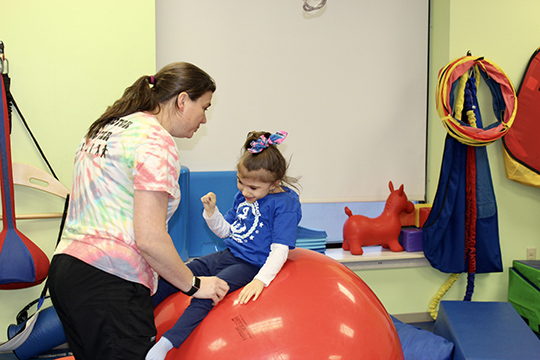
In the early stages of Teresa's pregnancy with her twin daughters, the doctors discovered it was Monochorionic Diamniotic (Mono/Di). Mono/Di twins are identical twins who share a placenta, but each has their own inner sac, meaning her twins had a higher risk of complications due to a shared blood supply. Everything was fine, and her twin girls, Sophia and Olivia, were being closely monitored. It wasn't until Teresa's 26-week checkup that her local doctors noted Twin-to-Twin Transfusion Syndrome (TTTS). TTTS is a rare condition that can occur with monochorionic pregnancies. This causes an imbalance in the blood exchange, and one twin gives away more blood than received, risking malnourishment and organ failure.
To balance out the fluid between the twins, the doctors performed an Amnioreduction and drained two and a half liters of fluid from Olivia, since she was overwhelmed with fluid. Everything was going well until five weeks later. "At my 31-week ultrasound, the doctors said it was time to get the girls out, and I needed an emergency Caesarean Section (C-Section)," stated Teresa. "Sophia was overwhelmed with fluid this time and Olivia was not getting enough fluids."
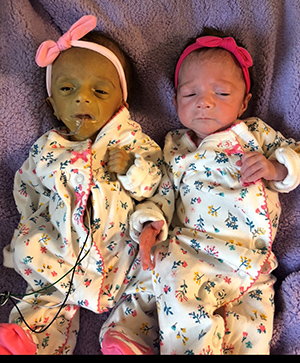 "The girls were born nine weeks early. Sophia weighed 4 pounds. because once she was delivered, she had Hydrops Fetalis, so fluid was just overtaking her body. It was seeping out of her. The doctors put in a drain to remove the remaining fluid, bringing her back down to 2 pounds, the same weight as Olivia," added Teresa. "After the girls were born, the doctors kept saying they were doing everything they could, but it didn't look good. About five hours later, we went to the Neonatal Intensive Care Unit (NICU), and the doctors said Sophia looked like a brand-new baby. Her heart was beating, and everything seemed to work itself out."
"The girls were born nine weeks early. Sophia weighed 4 pounds. because once she was delivered, she had Hydrops Fetalis, so fluid was just overtaking her body. It was seeping out of her. The doctors put in a drain to remove the remaining fluid, bringing her back down to 2 pounds, the same weight as Olivia," added Teresa. "After the girls were born, the doctors kept saying they were doing everything they could, but it didn't look good. About five hours later, we went to the Neonatal Intensive Care Unit (NICU), and the doctors said Sophia looked like a brand-new baby. Her heart was beating, and everything seemed to work itself out."
The following day, things changed. Sophia's platelets dropped, and a CT scan revealed she had a herniation on her brainstem, a grade IV brain bleed and hydrocephalus. Hydrocephalus is the accumulation of too much fluid in the brain and spinal cord. "Sophia's liver and kidney were also not functioning properly. The doctors gave her 72 hours to live and told us to hold her, hug her, and love her."
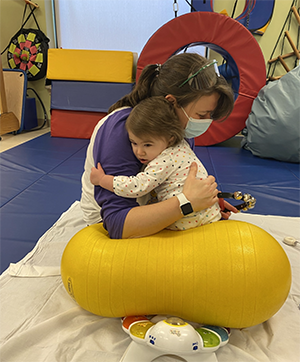 Five days passed, and Sophia was still breathing. Teresa advocated for her daughter and requested another CT scan. The scan could not confirm the herniation on her brainstem, so her local hospital decided to transport her to a hospital that exclusively cares for children. "The new neurologist team evaluated Sophia and told us to get her back to our local hospital for her remaining days with her twin sister and family. They told us she would need a shunt, but her body could never handle undergoing anesthesia since she was only 2 pounds," stated Teresa. "We got back to our local hospital, and they were administering morphine every 3 hours. I remember hearing alarms continuously going off and her heart rate dropping to the forties. And once again, we were told to hold and hug her because it was the beginning of the end. The doctors asked if we wanted to keep feeding her. I said, of course, I didn't want her to starve."
Five days passed, and Sophia was still breathing. Teresa advocated for her daughter and requested another CT scan. The scan could not confirm the herniation on her brainstem, so her local hospital decided to transport her to a hospital that exclusively cares for children. "The new neurologist team evaluated Sophia and told us to get her back to our local hospital for her remaining days with her twin sister and family. They told us she would need a shunt, but her body could never handle undergoing anesthesia since she was only 2 pounds," stated Teresa. "We got back to our local hospital, and they were administering morphine every 3 hours. I remember hearing alarms continuously going off and her heart rate dropping to the forties. And once again, we were told to hold and hug her because it was the beginning of the end. The doctors asked if we wanted to keep feeding her. I said, of course, I didn't want her to starve."
Time passed, and Sophia was still breathing. Sixty-three days went by, and Teresa asked for another test. "I didn't know what was happening. The holidays were coming up, and her sister was discharged," noted Teresa. The test revealed Sophia's brain had shifted back to midline, but more damage was done. Clots had formed in her brain, but it looked like she was going to survive.
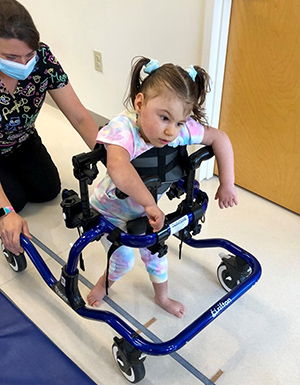 Coming Home
Coming Home
"The doctors asked us if we wanted to put Sophia in a facility. They said she wouldn't know who we are. She wouldn't walk. She wouldn't talk. It was going to be 24/7 care and it would be a thankless job. We have other little children at home, plus her twin sister, so we struggled with that, but we spoke to the hospital's ethics committee, who told us it was ethically ok if we wanted to put her in a facility. When we decided to bring her home with us, the doctors said she was probably going to aspirate in her sleep or catch an infection from her twin sister," said Teresa.
It was November 2019 when Sophia joined her family at home after 80 days in the NICU. "We started early intervention when the pandemic hit, so we had to do telehealth. Her hospital team suggested trying to find outpatient therapy as Sophia was diagnosed with Cerebral Palsy and needed more exercises and activities to help improve her muscle strength, balance, and movement. Luckily, our early intervention physical therapist worked per diem for Children's Specialized Hospital (CSH). She put me in touch with Stephanie Reahm, a physical therapist at CSH’s Egg Harbor Township facility. We started working right away," stated Teresa.
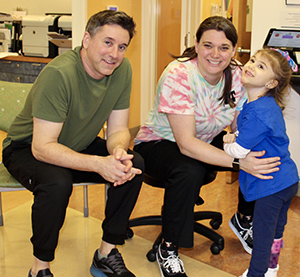 Strides to Reach Full Potential
Strides to Reach Full Potential
When Sophia started outpatient therapy at 10 months old, Teresa reflected on how she would cry a lot. "She has Cortical Vision Impairment, so she couldn't see well enough to understand what was happening. Stephanie is amazing and would always explain what was happening. She even took a seminar class on working with children with a vision impairment just so she could find better ways to treat Sophia,” added Teresa.
“Sophia’s family wasn’t sure that she was ever coming home, but she is a fighter and not only did she come home, but she is thriving,” stated Stephanie. “Sophia has been in physical therapy all her life between early intervention, outpatient, and school services. I personally have been working with Sophia since she was 10 months old and have been privileged to watch her steadily progress in all areas. When she came to CSH she was not sitting, rolling, or moving on her own.”
Sophia learned how to get herself into a sitting position in physical therapy. When lying down, she uses her left side to get herself up. "This is huge because sometimes, if we put her into the sitting position, Sophia would fall over, hyperextend, and be unable to get herself back up. Now, she can sit up on her own," highlighted Teresa.
“Sophia is also able to stand and move with increased independence. She is reaching, playing, and starting to talk more and more every day. She recently received a gait trainer to use at home and is starting to take steps in the gait trainer. We are currently working on getting her to walk on her own,” noted Stephanie.
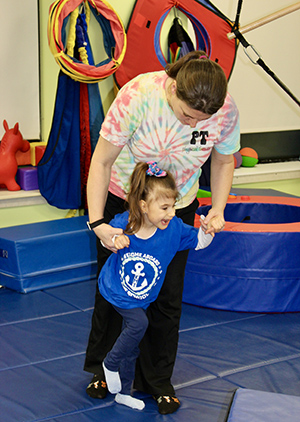 Sophia tolerates trying to walk with a gait trainer with support, sitting in a crisscross-applesauce position, pulling herself up, and using a scooter. Teresa noted, "We purchased the scooter Stephanie uses in PT sessions for around the house and school. She scoots around. It's great to see her have some independence. Before, she just laid there, and I remember crying to Stephanie, asking her if she thought Sophia would ever be able to sit up. Stephanie answered, ’We're going to get there."
Sophia tolerates trying to walk with a gait trainer with support, sitting in a crisscross-applesauce position, pulling herself up, and using a scooter. Teresa noted, "We purchased the scooter Stephanie uses in PT sessions for around the house and school. She scoots around. It's great to see her have some independence. Before, she just laid there, and I remember crying to Stephanie, asking her if she thought Sophia would ever be able to sit up. Stephanie answered, ’We're going to get there."
Sophia also receives Occupational Therapy with Jason Mostecki, where she's learning purposeful play. "She pushes a button and knows something is going to happen. Sophia's using her righty as a helper, which she has never done before. So, she pushes the button on her left side. Sophia has never had purposeful play. If you gave her something, she would automatically throw it," stated Teresa. “Sophia started occupational therapy services when she was 1 year old. She actually started with Jason’s wife, Megan Mostecki. It’s amazing to see how far she’s come with their knowledge and support.”
Jason noted, “During our therapy sessions we work on fine and visual motor development, bilateral integration hand skills, postural control, self-regulation/coping, sensory processing, and sensorimotor skill development. Through active and passive range of motion exercises coupled with reaching tasks and bilateral upper extremity strengthening and weightbearing activities, we seek to provide input to the shoulders, elbows, wrists, and hands. These movements can be challenging for Sophia, but she always puts forth her best effort.”
"Jason helps her with hand massages and stretching. Her hands are much more relaxed, and if she's given a stretchy toy, she'll take it with both hands and she can pull and stretch the toy. That's a big deal. Jason has made such amazing progress with her,” said Teresa.
“We balance the stretches with functional play activities and always try to make OT time fun. Sophia has made significant gains in her tolerance for therapeutic activities. Vestibular and proprioceptive sensorimotor input is provided through rolling on the large therapy ball, swinging on the swing, bouncing on the Jumperoo, sliding down the slide, and navigating the gym space while seated on the scooter. Sophia has a wonderful personality, smiles at and says ‘hi’ to everybody, pushes through adversity, and is simply a joy to work with,” highlighted Jason.
When reflecting on Sophia's PT and OT sessions, Teresa stated, "Steph and Jason make everything easy and accommodating. They point things out and share tips on what to work on at home. They really are doing their job to make a difference."
“Sophia is an amazing young girl that inspires me every day! I am blessed to be a part of her journey,” stated Stephanie.
Developing Beautifully
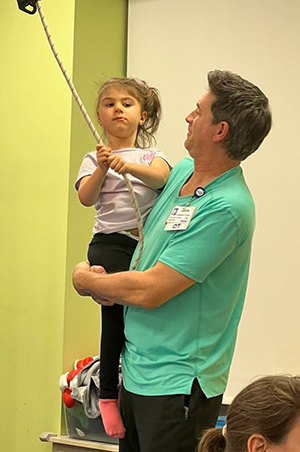 Sophia enjoys going to her therapy sessions and has made a tremendous amount of progress since she first started. "Even if she is having a bad day, Stephanie and Jason don’t give up on her. They just hold her. I've noticed they stretch her while she is being held. They're really amazing," highlighted Teresa.
Sophia enjoys going to her therapy sessions and has made a tremendous amount of progress since she first started. "Even if she is having a bad day, Stephanie and Jason don’t give up on her. They just hold her. I've noticed they stretch her while she is being held. They're really amazing," highlighted Teresa.
Stretching is a significant component of Sophia's OT and PT sessions. "Stretching made me nervous at first. They would use this big ball, grab Sophia's arms and legs, and roll her. I thought she was going to fall, but she loved it. I learned I could "rough play" with Sophia and treat her like her siblings. She loves the ball and listening to music. They play music in therapy, and Sophia gets happy and excited."
Teresa flashed back to when Sophia was born and how much she's progressed. Smiling, she said, "She's happy, making progress, developing beautifully, and thriving. I credit this to the staff that works with her. They are devoted and never gave up on Sophia. Her local hospital team cannot believe the stuff she's doing."
"Sophia receives therapy at school, but it’s only school based, it's nothing like CSH. At Children's Specialized Hospital, they're on top of everything. Their knowledge, compassion, and way of gaining Sophia's trust helps her interact with them successfully. The Egg Harbor Township outpatient facility celebrates every gain Sophia has. They're amazing, and I love what they do. We walk into the building, and they're so friendly. Security Officer Kent always says, ’Hi, Sophia!’ and she hears his tone and smiles. You see her eyes moving because she's trying to speak, listen, and understand. She smiles, waves, and blows kisses. When we're in the therapy session, the aide and other therapists watch and encourage her. It's so personable, and everyone has such a big heart. They look forward to seeing Sophia and the progress she's making. They didn't give up on her."
When reflecting on her greatest hope for Sophia, Teresa stated, "I want her to be able to do whatever is within her limits. I don't want her to ever want something and be unable to do it. I hope she always knows how special she is. I’m so inspired and proud to be her mom."
For parents going through a similar experience, Teresa highlighted the importance of therapy and not giving up. "Regardless of what the medical professionals say, just give your child every opportunity to thrive."
For more information, visit Children's Specialized Hospital.